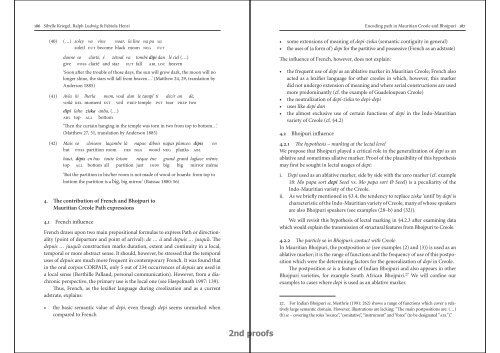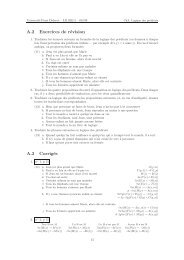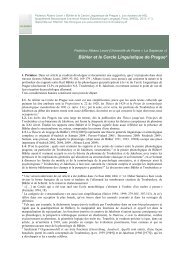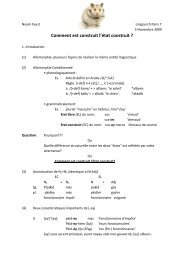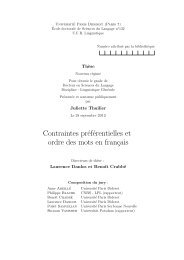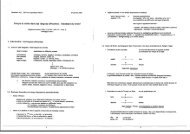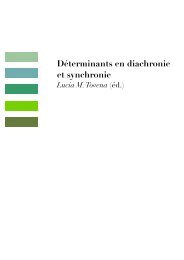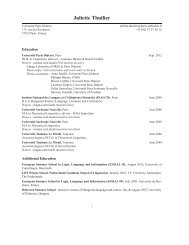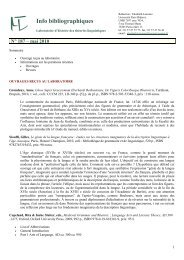Encoding path in Mauritian Creole and Bhojpuri - Laboratoire de ...
Encoding path in Mauritian Creole and Bhojpuri - Laboratoire de ...
Encoding path in Mauritian Creole and Bhojpuri - Laboratoire de ...
Create successful ePaper yourself
Turn your PDF publications into a flip-book with our unique Google optimized e-Paper software.
Sibylle Kriegel, Ralph Ludwig & Fabiola Henri<strong>Encod<strong>in</strong>g</strong> <strong>path</strong> <strong>in</strong> <strong>Mauritian</strong> <strong>Creole</strong> <strong>and</strong> <strong>Bhojpuri</strong> (40) (…) soley va v<strong>in</strong>e noar, la l<strong>in</strong>e na pa vasoleil become black moon donne so clarté, é zétoal va tombé dipi dan lé ciel (…)give clarté <strong>and</strong> star fall heaven‘Soon after the trouble of those days, the sun will grow dark, the moon will nolonger sh<strong>in</strong>e, the stars will fall from heaven…’ (Matthew 24, 29, translation byAn<strong>de</strong>rson 1885)(41) Avla ki lherla mem, voal dan le tampl ti décir an dé,voilà moment veil temple tear twodipi laho ziska anba, (…) top bottom‘Then the curta<strong>in</strong> hang<strong>in</strong>g <strong>in</strong> the temple was torn <strong>in</strong> two from top to bottom…’(Matthew 27, 51, translation by An<strong>de</strong>rson 1885)(42) Mais so cloisons laçambe là napas dibois napas plances: dipis enbut partition room wood planks haut, dipis en bas toute loison nèque éne gr<strong>and</strong> gr<strong>and</strong> laglace même. top bottom all partition just big big mirror même‘But the partition <strong>in</strong> his/her room is not ma<strong>de</strong> of wood or boards: from top tobottom the partition is a big, big mirror.’ (Baissac 1880: 56)The contribution of French <strong>and</strong> <strong>Bhojpuri</strong> to<strong>Mauritian</strong> <strong>Creole</strong> Path expressionsFrench <strong>in</strong>fluenceFrench draws upon two ma<strong>in</strong> prepositional formulas to express Path or directionality(po<strong>in</strong>t of <strong>de</strong>parture <strong>and</strong> po<strong>in</strong>t of arrival): <strong>de</strong> … à <strong>and</strong> <strong>de</strong>puis … jusqu’à. The<strong>de</strong>puis … jusqu’à construction marks duration, extent <strong>and</strong> cont<strong>in</strong>uity <strong>in</strong> a local,temporal or more abstract sense. It should, however, be stressed that the temporaluses of <strong>de</strong>puis are much more frequent <strong>in</strong> contemporary French. It was found that<strong>in</strong> the oral corpus CORPAIX, only 5 out of 234 occurrences of <strong>de</strong>puis are used <strong>in</strong>a local sense (Berthille Pallaud, personal communication). However, from a diachronicperspective, the primary use is the local one (see Haspelmath 1997: 139).Thus, French, as the lexifier language dur<strong>in</strong>g creolization <strong>and</strong> as a currentadstrate, expla<strong>in</strong>s: <strong>de</strong>pi, even though <strong>de</strong>pi seems unmarked whencompared to French <strong>de</strong>pi-ziska (semantic contiguity <strong>in</strong> general) <strong>de</strong>pi for the partitive <strong>and</strong> possessive (French as an adstrate)The <strong>in</strong>fluence of French, however, does not expla<strong>in</strong>:<strong>de</strong>pi as an ablative marker <strong>in</strong> <strong>Mauritian</strong> <strong>Creole</strong>; French alsoacted as a lexifier language for other creoles <strong>in</strong> which, however, this markerdid not un<strong>de</strong>rgo extension of mean<strong>in</strong>g <strong>and</strong> where serial constructions are usedmore predom<strong>in</strong>antly (cf. the example of Gua<strong>de</strong>loupean <strong>Creole</strong>)<strong>de</strong>pi-ziska to <strong>de</strong>pi-<strong>de</strong>pi<strong>de</strong>pi dan <strong>de</strong>pi <strong>in</strong> the Indo-<strong>Mauritian</strong>variety of <strong>Creole</strong> (cf. §4.2)<strong>Bhojpuri</strong> <strong>in</strong>fluence The hypothesis – mark<strong>in</strong>g at the lectal levelWe propose that <strong>Bhojpuri</strong> played a critical role <strong>in</strong> the generalization of <strong>de</strong>pi as anablative <strong>and</strong> sometimes allative marker. Proof of the plausibility of this hypothesismay first be sought <strong>in</strong> lectal usages of <strong>de</strong>pi:i. Depi used as an ablative marker, si<strong>de</strong> by si<strong>de</strong> with the zero marker (cf. example18: Mo papa sort <strong>de</strong>pi Sesel vs. Mo papa sort Ø Sesel) is a peculiarity of theIndo-<strong>Mauritian</strong> variety of the <strong>Creole</strong>.ii. As we briefly mentioned <strong>in</strong> §3.4, the ten<strong>de</strong>ncy to replace ziska ‘until’ by <strong>de</strong>pi ischaracteristic of the Indo-<strong>Mauritian</strong> variety of <strong>Creole</strong>, many of whose speakersare also <strong>Bhojpuri</strong> speakers (see examples (28–b) <strong>and</strong> (32)).We will revisit this hypothesis of lectal mark<strong>in</strong>g <strong>in</strong> §4.2.3 after exam<strong>in</strong><strong>in</strong>g datawhich would expla<strong>in</strong> the transmission of structural features from <strong>Bhojpuri</strong> to <strong>Creole</strong>. The particle se <strong>in</strong> <strong>Bhojpuri</strong>: contact with <strong>Creole</strong>In <strong>Mauritian</strong> <strong>Bhojpuri</strong>, the postposition se (see examples (2) <strong>and</strong> (3)) is used as anablative marker; it is the range of functions <strong>and</strong> the frequency of use of this postpositionwhich were the <strong>de</strong>term<strong>in</strong><strong>in</strong>g factors for the generalization of <strong>de</strong>pi <strong>in</strong> <strong>Creole</strong>.The postposition se is a feature of Indian <strong>Bhojpuri</strong> <strong>and</strong> also appears <strong>in</strong> other<strong>Bhojpuri</strong> varieties, for example South African <strong>Bhojpuri</strong>. 27 We will conf<strong>in</strong>e ourexamples to cases where <strong>de</strong>pi is used as an ablative marker. For Indian <strong>Bhojpuri</strong> se, Mesthrie (1991: 262) shows a range of functions which cover a relativelylarge semantic doma<strong>in</strong>. However, illustrations are lack<strong>in</strong>g: “The ma<strong>in</strong> postpositions are: (…)(b) se – cover<strong>in</strong>g the roles “source”, “comitative”, “<strong>in</strong>strument” <strong>and</strong> “force” (to be <strong>de</strong>signated “”).”2nd proofs


